Software-Defined Media Networks for contribution and distribution (SDMN)
Media companies and network operators are going full speed ahead with the building of converged multi-service networks. Instead of keeping multiple old, single-purpose networks up and running, upgrading to all-IP and cloud-connected networks gives them higher flexibility to run a variety of applications on a single converged network: media file exchanges, live news gathering, OU sports and other events, inter-studio exchanges, REMI, cloud media pipelines including file transcodes, QA management and OTT distribution, and much more. Every system and operator can produce and consume content anywhere. This is what true convergence is about.
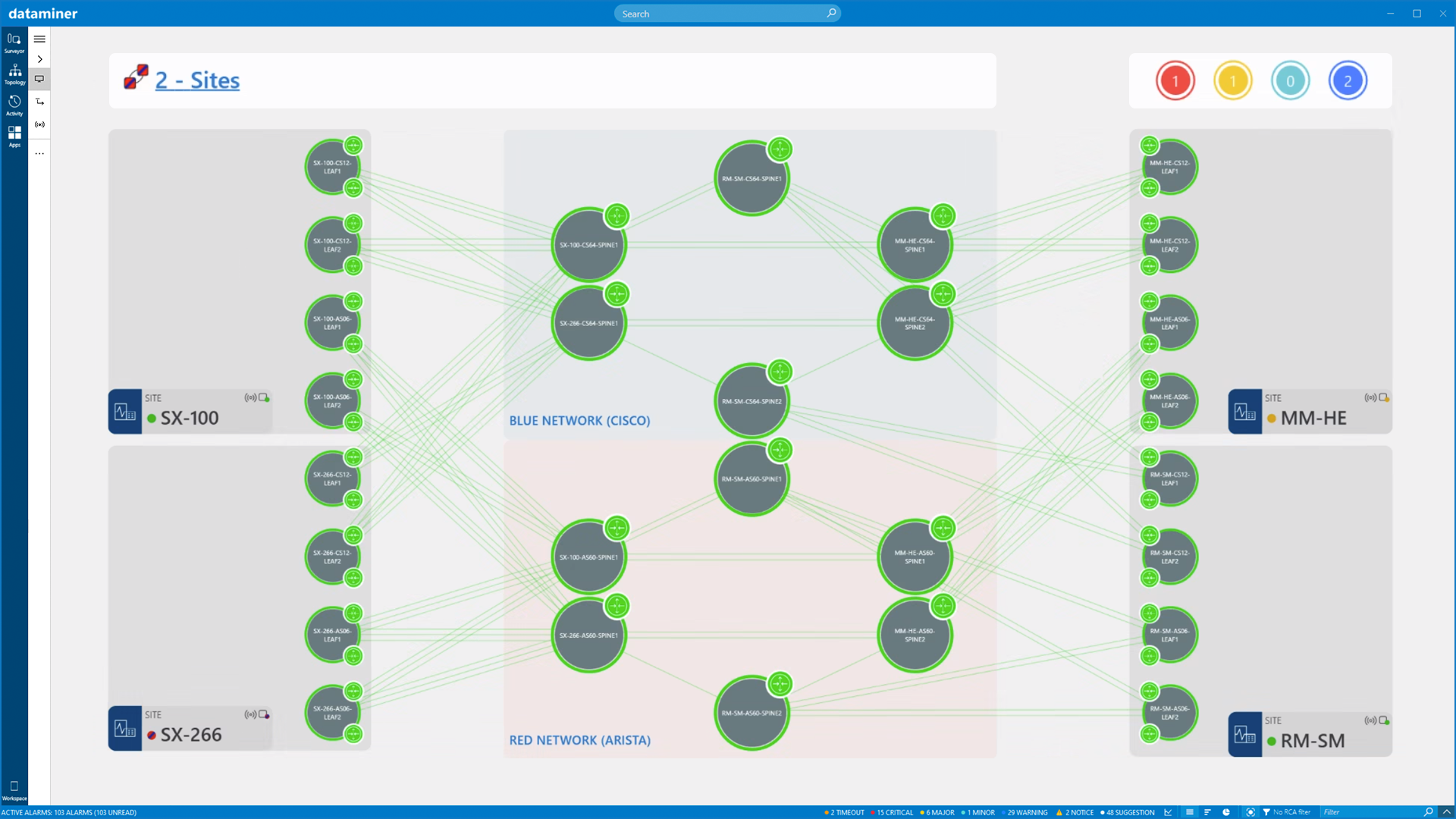
While the core network and cloud technology is readily available, running ICT, data and media services all in one, media flows do require special care. To begin with, media flows are large, require minimal delay, and are intolerant to excessive jitter. Video, audio and metadata flows also all need to remain perfectly in sync. And last but not least, the endpoints are difficult to manage and monitor. Endpoints are cameras, vision mixers, graphics engines, IP media gateways and firewalls, media processors, origin servers for OTT, and much more.
It doesn’t come as a surprise that organizations typically use over 50 different tools to manage network inventory, monitor and control the network, automate some of the workloads, and troubleshoot incidents.
DataMiner aligns the needs of highly available, large-capacity media networks with dynamic media life cycle service orchestration (LSO) from producer to consumer: full SDN control of core and edges, network capacity planning, virtualized on-premises or public cloud functions (NFV), full OSS/BSS integration, cloud collaboration, and much more. DataMiner approaches this entire operation holistically, supporting every aspect of a successful media network.
Empower your media network operations without any compromises
Any network topology
DataMiner works with any network topology, such as mesh, spine-leaf, point-to-point inter-facility WAN interconnects, redundant rings, secured private connections to public cloud, etc. While local networks are frequently engineered to be non-blocking, WAN connectivity relies on the DataMiner capacity planning and reservation to avoid oversubscriptions on capacity-constrained links (blocking networks). No matter which redundancy scheme you want to use, DataMiner will support it, including an air-gapped network. The latter is also called a red and blue or a purple network architecture. This is typically a single spine-leaf network where DataMiner’s SDN control intelligence makes sure that redundant media flows are routed to a receiver via diverse paths and switches in the same network.
Any media format
DataMiner is agnostic to your media formats. You can easily run uncompressed media, as well as visually lossless lightly compressed (JPEG-XS, TICO, etc.), contribution-quality compressed (H.264 4:2:2, etc.) and distribution content (H.264, AV1, VVC, etc.) over your converged network. You also enjoy the freedom of being able to use a mix of transport protocols for video (SMPTE ST-2022, SMPTE ST-2110, HLS, DASH, etc.), audio (AES-67, Dante, Ravenna, etc.) and any other auxiliary data streams.
Any product, appliance, on-premises and cloud function
Then there’s the plethora of different vendors and interfaces, especially for media edge functions. DataMiner guarantees the ability to interface with any edge function and network component available on the market. Operators have the freedom to design their “best-of-breed” solution, attuned to their needs. Of course, DataMiner supports industry standards, including NMOS specifications (IS-04, IS-05, IS-07, IS-08, etc.). Moreover, in case media functions do not support auto-discovery and connection management using open standards, DataMiner will readily supply those functions using vendor-specific protocols.
DataMiner integrates with any product and SaaS service from any vendor: on-premises hardware, appliances and virtualized platforms (COTS or FPGA based), on-premises ICT infrastructure, but also functions or services running in the private and public cloud (multi-cloud). Media fabrics from any supplier are readily integrated, and DataMiner allows you to use different suppliers for RED and BLUE networks. That is truly unique in the industry. Naturally, DataMiner effortlessly includes your legacy technology like SONET/TDM, ASI, RF and SDI into the end-to-end operation as well.
Automate your entire Inventory Management
DataMiner Infrastructure Discovery and Provisioning (IDP) is indispensable for the secure management of large-scale and geographically spread networks. DataMiner keeps track of the as-is discovered inventory (including discovery using NMOS IS-04 registries), fully automatically provisions products into the system (zero-touch provisioning), detects and keeps any network topology up to date (e.g. scanning LLDP entries), reports gaps and mistakes in your CMDB and corrects those, executes your software updates during your planned maintenance slots, and also takes configuration backups and configuration restore.
DataMiner actively makes your networks more secure: the platform reports unvalidated software images and non-compliant configurations. Operators can even configure DataMiner to auto-remediate unsafe situations.
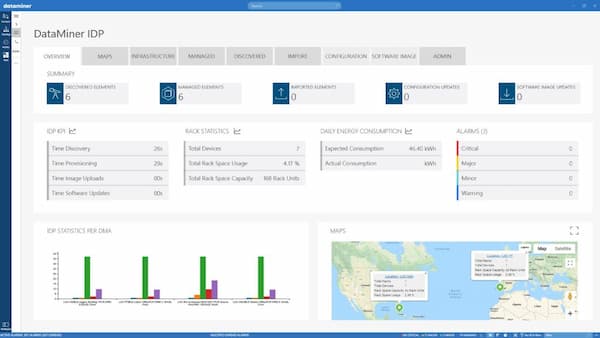
Itching to get started?
Scroll down and claim your free resources
to start empowering your media network operations today

Establish connections effortlessly with the built-in multi-vendor SDN controller
Whether connections are permanent or occasional, users can easily establish these in the network, point to point, point to multipoint, or mesh. DataMiner comes with a built-in multi-vendor SDN controller for core, edge and cloud connections. This is a huge difference compared to multiple distinct SDN controllers, each supplied by specific vendors.
Orchestrate from a single pane of glass
Control of core network switches and fabrics, but also of media edges and cloud functions means that the entire pipeline is orchestrated and monitored from a single pane of glass, conveniently and efficiently.
Minimize network outages due to software issues
Support for functions (e.g. IP spines and leaves) supplied by multiple vendors, e.g. your core BLUE network may be Arista, while your core RED network may be Cisco – or any other vendor. Operationally, it does not make a difference when using DataMiner. From a resiliency perspective, the difference is huge. In today’s software-savvy world, software issues are a much more frequent cause of outages than hardware failures. That means that replacing one product with a product of the same vendor and model often isn’t enough to resolve an issue!
Optimize your flows with intelligent flow engineering
With Dijkstra-based intelligent flow engineering, in addition to making decisions on the cost of a link, DataMiner also takes into account a variety of other criteria: configuration settings (e.g. only use ports with a given interface name or property), monitored parameters (e.g. select paths with IF utilization under a certain threshold), capabilities (e.g. only use 10G ports, only use ports assigned to a certain customer, avoid nodes in certain locations, etc.), flows already running (e.g. avoid all nodes that are already used for a certain other connection, etc.), and so on.
Orchestrate your flows how you see fit
Pick and choose the way you orchestrate flows: IGMP v2, source-specific IGMP v3, static multicast routes on each node (passive SDN mode), or a mix. DataMiner matches your preferences.
Choose your ideal media stream redundancy option
Media stream redundancy comes in many flavors, with different benefits and cost points. Single flow, redundant flows (SMPTE ST 2022-7 transport redundancy), quad redundancy (source and transport redundancy), and so on: all workloads can be set up in DataMiner. Just pick the optimal scheme for each connection in your network.
Manage your resource bookings automatically
With the included functionality of DataMiner Service and Resource manager (SRM), DataMiner will not only avoid setting up flows that would instantly oversubscribe the network, but also avoid booking future flows that would oversubscribe links in days or weeks. DataMiner SDN orchestrator is fully deterministic for planning OU flows: DataMiner manages the resource reservation timelines of each network function and IF.
Integrate seamlessly with vendor-specific controllers
If you still prefer to also use vendor-specific controllers such as Cisco DCNM, Arista MDC, OpenFlow controllers, or others in your ecosystem, DataMiner can perfectly integrate with those subsystems. It should be noted though that depending on the specific features of those 3rd party controller, it may be hard or even impossible to achieve end to end deterministic behavior in the network. In general, the more controllers involved, the higher the complexity.
Fully automate your SecOps
Security is of course of crucial importance. DataMiner SDMN not only sets up the data plane, but also fully automates your SecOps as part of the connection life cycle. For instance, senders are only included in the ACL lists when the operator has indicated that the sender is in use, and receivers are only authenticated in the network while they have the necessary rights. Orchestration of ACL lists, flow policies, host policies, NAT at ingress and egress ports: it’s all inherently included in the DataMiner SDMN service lifecycle orchestration (LSO).
Service and IP flow observation on a single pane of glass
DataMiner automates orchestration and monitoring into its connection service life cycle (LSO) management. Consequently, it knows when a connection is started, paused, stopped, resumed, switched to redundant, etc. Since DataMiner automatically aligns monitoring schedules with service LSO schedules and states, operators do not have to do anything to enable monitoring on the system (zero-touch provisioning). The platform will autonomously monitor services and their associated IP flows, and it will signal any degradations or outages. Similarly – and of key importance in any virtualized and all-IP network – DataMiner will signal flows and instances that run on the network unexpectedly. This is called service life cycle–aware monitoring: it ensures that no flows are left unmonitored at any point in time, it avoids presenting false positive alarms to operators, and it facilitates detection of ghost flows that are unexpected in the network at a given time.
Observability is the result of collecting data originating from just about any source of information. Collection of counters using data polling, collection of event logs and trace files, capturing stream telemetry: any method is supported in DataMiner, regardless of the protocols used (SNMP, RESTful APIs, CLI, OpenConfig, Kafka, Prometheus, sFlow, etc.). The resulting DataMiner unified data lake is a true digital twin of your operations. DataMiner aggregates and processes that data and turns it into comprehensive dashboards and actionable alarms, it augments data using artificial intelligence, and it does all this with the purpose of providing maximum observability and convenience for any team to consume the data.
Precision Time Protocol management: if the clock fails, the network fails
Transporting and switching media flows in the network requires perfectly synced video, audio and metadata flows at all times. Network service providers and media companies rely on the Precision Time Protocol (PTP). SMPTE ST 2110 also relies on PTP. Properly configuring and maintaining a stable and reliable PTP ecosystem is a continuous challenge, with complex underlying network architectures, the need to configure PTP-aware switches, a vast number of PTP follower devices from multiple vendors, the setup of the best master clock algorithm (BMCA) … lots of things can go wrong.
The DataMiner PTP app collects and correlates data from each PTP node and interfaces with third-party PTP network analyzers to achieve true 360° real-time PTP observability. The app immediately informs operators about network degradations or any PTP state changes, originating from GNSS (global navigation satellite system) down to every PTP follower device, to ensure a stable and reliable PTP environment. 24/7 in-depth PTP monitoring, keeping track of the PTP configuration, behavioral analysis and change detection, performance tracking of every single PTP node over time … it has all become a must-have. This is exactly what the DataMiner PTP app does for you.
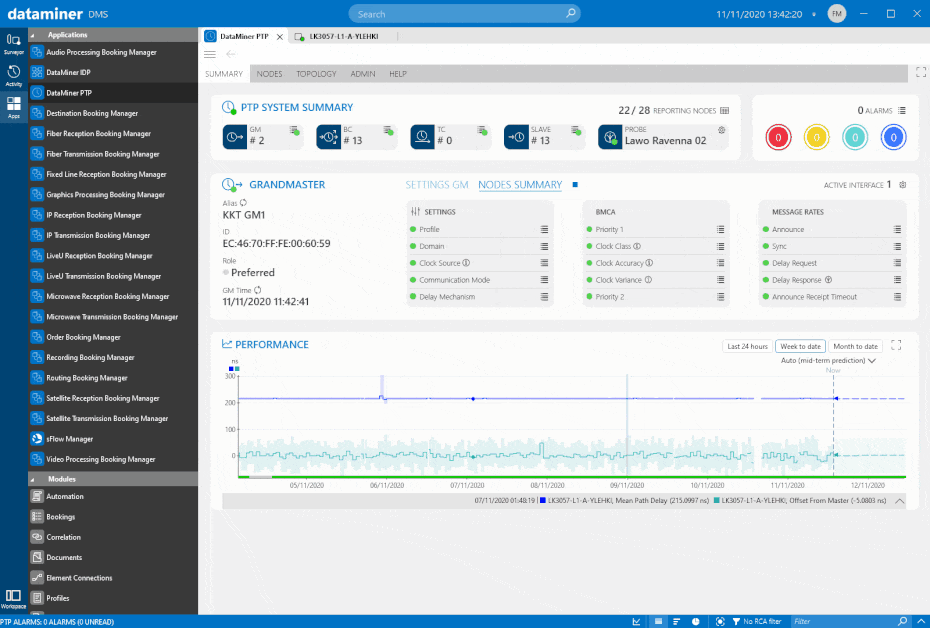
Security first
Security is a hot topic in the media and broadband industry. DataMiner assists your SecOps team by applying and automating security workflows in a highly repetitive and consistent manner. This prevents situations like some of the large breaches that occurred recently, which were caused by security guidelines that were simply forgotten. DataMiner automation augments security levels significantly in your operation.
Security starts with managing the boundaries of and access to the network itself. A continuous scan of your network inventory and connections, capturing configurations and checking policies, checking software image updates and reporting deviations to approved versions: DataMiner automatically detects and signals changes and policy violations, and can even automatically restore the network to a safe state or shut down unsafe ports and segments.
Even if your network inventory is secure, using the network opens opportunities for breaches. There are plenty of things you can and should do to improve security with every signal connection you make in the network:
- Dynamically add or remove ACL entries and flow policies.
- Turn access port admin states on or off based on service schedules.
- Assign ports and/or bandwidth to a pre-defined set of users only.
- Set up edge destination access control to specific flows during allowed intervals only (host policy orchestration).
- Add QoS flow policies dynamically to IP flows for each flow type (compressed and uncompressed video profiles), audio and ancillary data streams.
- Use passive network routing (via the DataMiner SDN controller) instead of IGMP.
- Connect to network and edge resources in the most secure manner (secured API connectivity).
Convenience is essential in complex operations
Software-defined networks are complex – that’s a given. DataMiner makes it easy and convenient, with various options to develop and operate (DevOps) the most convenient control surface for each team and each user (personalized control surfaces). Those can be simple software button panels, integrations with physical router control panels, a wizard-style connection control surface or some other user interface. It’s all possible with DataMiner.
The openness of the DataMiner platform is further underlined with a variety of APIs and webhooks that can be used to neatly integrate the platform into your existing operational environment.
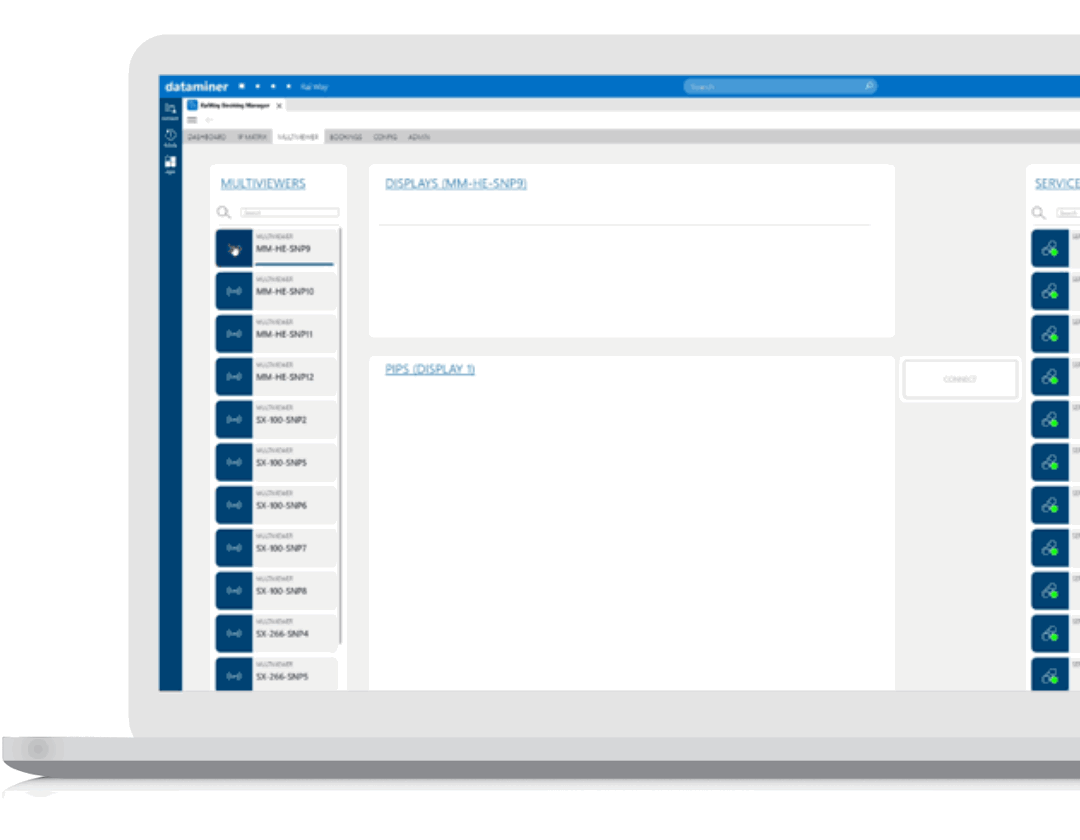
Collaboration drives digital transformation
Monitoring and controlling your media network today is no longer limited to a small team of experts within your company. Building a multi-tenant network operation has never been easier with DataMiner’s customer portals and real-time performance and SLA reporting capabilities. You can even give control to your colleagues and share a button panel permanently or temporarily, for example during a sports event to manage return feeds from your NOC or MCR back to the stadium, inside or even outside of the organization, without compromising security.
Interconnect your networks using DataMiner’s open and user-definable webhooks for connection planning and booking, service life cycle management, service health monitoring and assurance reporting, and much more, turning a closed network into a flexible and globally interconnected network.
Learn more with our free webinars
Please note that you need to be logged in to access our video library: in the top corner of the screen, click LOG IN and authenticate yourself with your corporate email address.
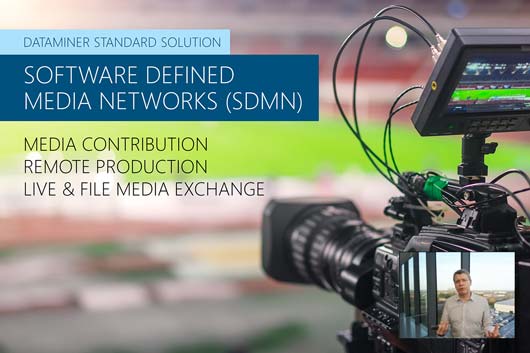
Part 1: Service Orchestration
YOU'LL LEARN
- why DataMiner SDN orchestration goes above and beyond
- why resource management makes LSO reliable and predictable
- how to get a 360° view on your service life cycle health
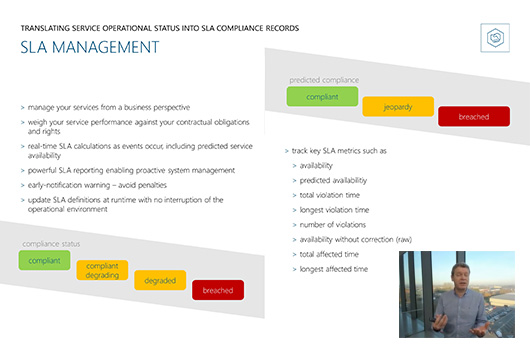
Part 2: Service Assurance & SLA Management
YOU'LL LEARN
- how DataMiner manages the service life cycle across edge and network domains, regardless of technology, transport layer (SDH, SMPTE 2022, SMPTE 2110), and switching and routing paradigms (source, network, destination)
- how DataMiner also monitors services, transport, synchronization and infrastructures in a schedule-aware manner
Request our free White Paper

SDN Orchestration explained
This white paper explains how to build an SDN solution for media, and what your options and possibilities are. As there is no single blueprint that fits everyone’s needs, each deployment will be (at least) slightly different. This white paper will help you make the right decisions up front.
Longread blog post series
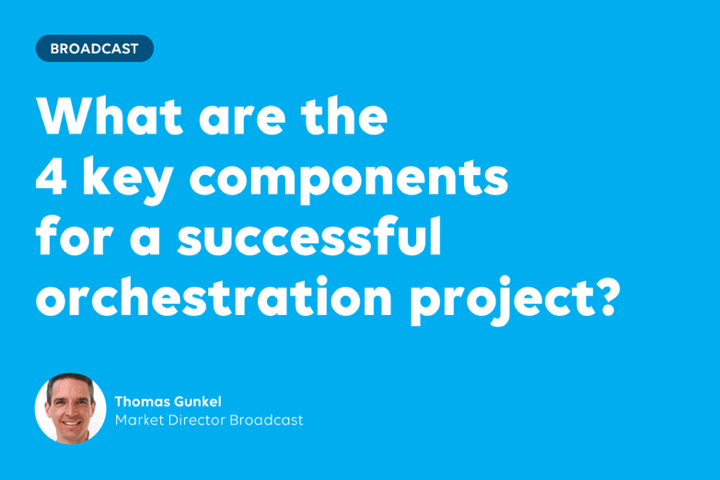
Controllers and Orchestrators for Broadcast: which is which?
In this series of 6 blogs you will learn the differences between orchestrators and controllers and how DataMiner either fulfills all four building blocks (onboard, plan, control, monitor) of a service orchestration platform on its own or, alternatively, leaves the control part to a third-party controller. The right solution depends on your use case.
Let's talk about your project
Are you interested to know if this standard solution also offers possibilities for your project? You can either ask your question right here on our Dojo community. Or, if you prefer the more personal touch, you can also contact your local sales representative. Either way, our DataMiner experts will be happy to discuss all the possibilities with you, down to the smallest detail.
Associated Markets:
Media ProductionMedia Production - Production Event Management
Media Production - Studios & Production
Service Providers
Service Providers - Cloud
Service Providers - Cloud - CDN
Service Providers - Network
Service Providers - Network - Media
Content Distribution
Content Distribution - IPTV
